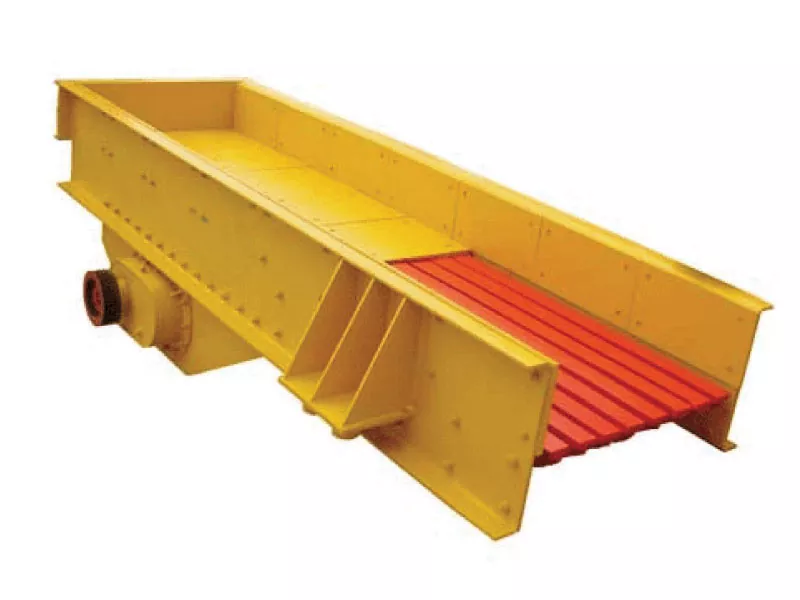 English
English Español
Español  Português
Português  русский
русский  Français
Français  日本語
日本語  Deutsch
Deutsch  tiếng Việt
tiếng Việt  Italiano
Italiano  Nederlands
Nederlands  ภาษาไทย
ภาษาไทย  Polski
Polski  한국어
한국어  Svenska
Svenska  magyar
magyar  Malay
Malay  বাংলা ভাষার
বাংলা ভাষার  Dansk
Dansk  Suomi
Suomi  हिन्दी
हिन्दी  Pilipino
Pilipino  Türkçe
Türkçe  Gaeilge
Gaeilge  العربية
العربية  Indonesia
Indonesia  Norsk
Norsk  تمل
تمل  český
český  ελληνικά
ελληνικά  український
український  Javanese
Javanese  فارسی
فارسی  தமிழ்
தமிழ்  తెలుగు
తెలుగు  नेपाली
नेपाली  Burmese
Burmese  български
български  ລາວ
ລາວ  Latine
Latine  Қазақша
Қазақша  Euskal
Euskal  Azərbaycan
Azərbaycan  Slovenský jazyk
Slovenský jazyk  Македонски
Македонски  Lietuvos
Lietuvos  Eesti Keel
Eesti Keel  Română
Română  Slovenski
Slovenski  मराठी
मराठी  Srpski језик
Srpski језик
Why Should You Choose a Motor Vibrating Feeder for Your Production Line?
2025-09-11
In modern industries where bulk materials need to be processed, handled, and transferred efficiently, the Motor Vibrating Feeder has become an essential piece of equipment. Whether in mining, metallurgy, building materials, or food processing, this device ensures a continuous and controlled flow of material without blockages or irregular feed rates. Companies such as Qingdao EPIC Mining Machinery Co.,Ltd. have invested heavily in the design and manufacture of high-performance feeders that meet global standards and user expectations.
But what exactly makes the Motor Vibrating Feeder stand out from other feeding equipment? And how can you evaluate its specifications to determine whether it fits your project? Let's dive into its functions, technical parameters, and practical benefits.
What Is a Motor Vibrating Feeder?
A Motor Vibrating Feeder is a mechanical feeding device powered by dual vibration motors. These motors generate linear vibrations that move materials forward in a uniform and controlled way. Unlike traditional feeders that rely on belts or mechanical pushers, this type of feeder uses vibration as its driving force, minimizing wear, reducing maintenance, and ensuring consistent performance.
It is commonly installed under hoppers, bins, or silos, transporting materials such as ores, coal, gravel, cement, chemical powders, and even food grains. Its ability to handle both fine powders and large-sized lumps makes it versatile across multiple industries.
Key Features of Motor Vibrating Feeder
To better understand why this equipment is so widely used, here are its core features:
-
Uniform Feeding: Ensures steady and continuous delivery of materials to crushers, screens, or conveyors.
-
Adjustable Amplitude: Feeding capacity can be controlled by adjusting vibration intensity.
-
Low Energy Consumption: Efficient motor design reduces power usage compared to other feeding systems.
-
Durability: Built with wear-resistant liners and high-quality steel structures for long service life.
-
Easy Maintenance: Fewer moving parts mean reduced breakdowns and quick servicing.
-
Low Noise: Modern designs ensure smooth operation with minimal vibration noise.
Technical Parameters of Motor Vibrating Feeder
Choosing the right Motor Vibrating Feeder requires a clear look at its specifications. Below is a simplified table highlighting common models and their technical parameters.
| Model | Capacity (t/h) | Feeding Size (mm) | Motor Power (kW) | Weight (kg) |
|---|---|---|---|---|
| GZD-250×75 | 80 – 120 | ≤ 300 | 2×1.5 | 2000 |
| GZD-300×90 | 120 – 200 | ≤ 400 | 2×2.2 | 2500 |
| GZD-380×96 | 200 – 350 | ≤ 500 | 2×3.7 | 3500 |
| GZD-490×110 | 350 – 500 | ≤ 600 | 2×5.5 | 4500 |
| GZD-590×130 | 500 – 800 | ≤ 700 | 2×7.5 | 6000 |
These parameters are examples based on common industrial applications. Custom feeders can be designed by Qingdao EPIC Mining Machinery Co.,Ltd. to match client-specific requirements such as higher throughput, stronger structural reinforcement, or special liners for corrosive materials.
Applications of Motor Vibrating Feeder
The wide range of applications is one of the main reasons this equipment is highly demanded worldwide. Typical industries include:
-
Mining & Quarrying: Feeding ores and aggregates into crushers or screening systems.
-
Cement Industry: Feeding raw materials like limestone and clinker.
-
Metallurgy: Handling coal, iron ore, and steel production inputs.
-
Chemical Industry: Feeding powders and granules in controlled quantities.
-
Food Processing: Moving grains, seeds, or additives in hygienic environments.
This adaptability allows businesses to invest in a single type of feeder that works across multiple operations.
Advantages of Using Motor Vibrating Feeder
Why do so many companies prefer Motor Vibrating Feeders over alternatives? Here are some clear advantages:
-
Consistent Material Flow → Reduces downtime caused by irregular feeding.
-
Energy Savings → Low power consumption compared to belt feeders.
-
Reduced Labor Dependency → Automatic feeding minimizes manual supervision.
-
Extended Equipment Life → Even feeding prevents blockages and reduces stress on downstream machinery.
-
Flexible Control → Operators can adjust the feed rate based on production needs.
These advantages not only improve operational efficiency but also contribute to long-term cost savings.
Installation and Operation
The Motor Vibrating Feeder is designed for simple installation. Here are the general steps:
-
Place the feeder on a stable foundation with vibration-absorbing pads.
-
Align it with the discharge outlet of the hopper or silo.
-
Connect power to the dual vibration motors.
-
Adjust the vibration amplitude and angle to achieve desired feeding flow.
-
Test run the equipment to confirm uniform feeding.
Routine checks include inspecting motor bolts, liners, and springs to ensure long-term stability.
Maintenance Recommendations
Although the feeder requires minimal maintenance, regular inspection ensures consistent performance:
-
Weekly Checks: Tighten motor bolts, check spring tension.
-
Monthly Inspections: Verify amplitude, motor synchronization, and lubrication.
-
Wear Parts Replacement: Replace liners or trough plates when worn.
-
Motor Care: Keep motors dust-free and well-lubricated.
With these practices, the Motor Vibrating Feeder can operate smoothly for years with minimal downtime.
Common Questions
Q1: What materials can a Motor Vibrating Feeder handle?
A Motor Vibrating Feeder can handle fine powders, small granules, and large lumps up to 700mm in size, depending on the model. It is widely used for ores, coal, limestone, chemicals, and even food grains.
Q2: How can I control the feeding capacity?
Feeding capacity is controlled by adjusting the vibration amplitude, motor speed, and trough angle. Operators can fine-tune these settings to match downstream equipment requirements.
Q3: What is the typical lifespan of a Motor Vibrating Feeder?
With proper maintenance, feeders manufactured by Qingdao EPIC Mining Machinery Co.,Ltd. typically operate for 8–10 years before requiring major overhauls. Wear parts may need replacement more frequently depending on material abrasiveness.
Q4: Can the feeder be customized for special applications?
Yes. Custom solutions are available for corrosive materials, high-temperature environments, or heavy-duty mining operations. Structural reinforcements, stainless-steel liners, and dust covers can be added upon request.
Why Work with Qingdao EPIC Mining Machinery Co.,Ltd.?
When selecting a Motor Vibrating Feeder supplier, expertise and reliability matter. Qingdao EPIC Mining Machinery Co.,Ltd. offers:
-
Over 15 years of experience in manufacturing feeders for global markets.
-
Advanced production facilities with strict quality control.
-
Tailor-made designs for specific industry requirements.
-
Competitive pricing with guaranteed after-sales support.
By choosing a trusted supplier, you ensure that your investment delivers long-term value and dependable performance.
Final Thoughts
The Motor Vibrating Feeder is not just another piece of equipment; it is a backbone for continuous material handling in industrial operations. From mining to food processing, it guarantees efficiency, reliability, and cost-effectiveness.
Understanding its features, specifications, and proper maintenance ensures you get the most out of your feeder. Partnering with experienced manufacturers like Qingdao EPIC Mining Machinery Co.,Ltd. gives you the assurance of quality products and dedicated service.
For inquiries, technical consultations, or customized solutions, please feel free to contact Qingdao EPIC Mining Machinery Co.,Ltd. — your trusted partner in advanced feeding equipment.





